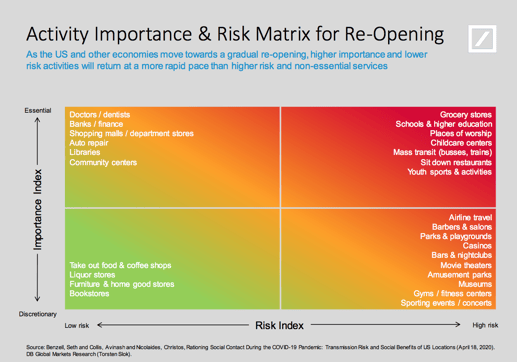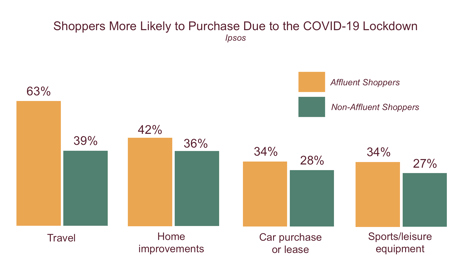Pent-up demand and what it means for marketers
May 21, 2020

One of the most fascinating effects of the COVID-19 lockdown has been the impact on consumer behavior. As we’ve discussed before, some of those behaviors have undergone rapid and likely long-term changes, particularly as it relates to our digital lives.
But the re-opening is quickly revealing something else just as relevant to marketers charged with plotting the course for their brands: the very real pent-up demand that exists for all kinds of goods and services. In the near term, understanding this demand and planning for how to address it should be job one.
One way to explore this demand is alongside a matrix like the one below, courtesy of Deutsche Bank’s Life After COVID study, which measures the perceived risk of numerous consumer activities in relation to their perceived importance.

While a great starting place, this doesn’t tell the whole story. Indeed, the past few weeks have made clear that many people are quite willing to re-engage in consumer behaviors that are neither essential nor considered low risk as it relates to COVID-19.
Based on our own research, here are the areas most likely to see a surge in consumer activity due to pent-up demand.
Essential services
This is a no brainer. If you’re charged with marketing an essential service, you should be pulling extra hours right now getting the word out. The good news is that most essential services fall into the “high need” and “low risk” categories, so people feel better about getting out and taking care of these needs than just about anything else. This might include health services like doctors appointments, delayed trips to the dentist, or even automotive and home repairs that took a back seat during the lockdown.
Appointment spending
We’ve all seen the “COVID hair” memes that have humorously reflected an entire society in desperate need of a haircut. So it should come as no shock that as restrictions ease up, people are rushing back out to their barbers and hair stylists. Many of these small businesses have done a great job of actively engaging their customer bases to keep them informed of what the new normal looks like for them, something we strongly encouraged here.
But beyond hair, demand has revealed itself for most any consumer activity that could be considered “appointment spending.” This includes fitness activities, nail salons, oil changes, and many other ongoing consumer needs that have suddenly gone unfulfilled. Any business that’s built around scheduled activities and services should be raising its hands high right now to let their customers know they’re ready to meet any pent-up needs, because the demand is certainly there.
Travel
New reporting from Skift shows just how sharply all travel has declined in the first half of 2020. While 46% of Americans engaged in some form of travel in January, that figure had plummeted to a staggeringly low 18% by April. And most of that travel was for essential reasons related to family obligations. Leisure travel for vacations, meanwhile, fell though the floor.
This may be about to change. The study shows that from April to May, the number of consumers who expect to increase spending on travel has doubled, a great indicator of pent-up demand. Cruise bookings, believe it or not, are already up an astounding 600%.
Among those who deferred or rescheduled travel plans, many essentially changed those plans from spring to summer. Others have been actively researching options for travel over the summer period. This only makes sense, as the timing of the lockdown forced millions of Americans to scrap Spring Break travel plans. Now, with restrictions easing, they’re ready to make up for those lost days in the sun.
All that said, we still believe that the top benefactors of this trend will be drive destinations that allow for plenty of social distancing and crowd avoidance, a good sign for certain beach and mountain destinations, but not so good for urban areas requiring air travel to get there.
Luxury goods and services
A recent study from Ipsos revealed that affluent consumers are far more likely to be the first consumers out of the gates to meet many of their pent-up needs. That’s welcome news for upscale brands in several categories when they consider who they should be targeting as the country reopens.

As the above chart shows, pent-up demand among affluent consumers is real, as is the money they have to spend right now, on everything from travel to new cars.
The luxury automotive space is an especially interesting indicator. Barron’s reports a noteworthy uptick in luxury car searches, with online platforms such as Cars.com enjoying encouraging lifts in people seeking out higher-end cars. Indeed, searches for cars above $30,000 have nearly doubled in the past month alone.
Big ticket items
It’s not just the well heeled who may be car hunting right now. The same Barron’s report also notes that one-fifth of people who currently don’t own cars are now actively considering buying one. Much of this trend is attributed to broad-based consumer concerns over the safety of ride sharing and public transport going forward, but it’s clear that the longer the pandemic drags on, the greater demand will be for new and used cars.
Demand is up as well for another big ticket purchase item: homes. Home sales are starting to show positive signs after a dreadful first quarter. Spring is typically the busiest time of the year in real estate, as families plan to move over the summer before the new school year. But in April during the height of the lockdown, sales were down nearly 18% over last year. Given lockdown recommendations, sellers understandably pulled homes off the market, creating a combination of pent-up demand and shrinking inventory. In Austin, as in many other markets, home prices are now actually on the rise because of this trend, with properties receiving multiple offers and selling faster than a year ago. We can expect more of this demand to reveal itself in the weeks ahead as states loosen restrictions and families rush out to make those summertime moves.
Another factor that’s moving the needle for cars and homes alike is the extraordinarily favorable financial incentives being offered to auto and home buyers, from historically low mortgage rates to deferred payment plans for new cars. And it's worth pointing out that both of these industries have done a great job of staying top-of-mind with potential buyers throughout the COVID crisis, another of our key recommendations for marketers.
The bottom line is that the longer people have found themselves stuck at home, the more their needs have grown in multiple ways. The resulting pent-up demand is real, and marketers in most any industry should be on the lookout not only for what that demand looks like, but also those consumer groups that are most likely feeling it. They could represent all new audiences of future loyalists while generating much needed sales today.
See more Marketing insights below on how to navigate your brand through the COVID-19 Crisis:





